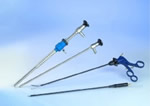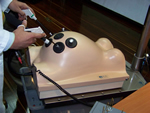Within video endoscopic procedures that are part of the surgery minimally invasive, the video laparoscopy is the most important, and with greatest potential operative in modern Gynecology
Even though there was and there is resistance to adopt this method in operative procedures of the female pelvis time has shown its safety and clear advantages when compared with the traditional open surgery.
Experience, skills and equipment and instruments specially developed for the female pelvis contributed enough so gynecological laparoscopy has become the method of choice in many gynecological surgery International centres. I accept that I had a long period of observation and skepticism but before current evidence and the results that we have obtained, I must say that there is no best surgical method for surgical treatment of female pelvic pathology. This is the future, the large pelvic incisions will be forgotten
Of course there are contra-indications and formal indications but as you get more experience the contraindications for the method are increasingly less.
Because the laparoscopy is striking?
To inflate the abdomen with air (actually is CO2, carbon dioxide) separate structures and spaces increase in size, on the other hand, video systems have increased so that everything looks great and easy to treat. On the other hand instruments are more sensitive and efficient handling of tissues is less traumatic and therefore reduces the risk of bleeding, infections, and postoperative pain. The surgical gestures are much more efficient and there is no excessive manipulation of abdominal organs or the placement of compresses or foreign bodies, another reason that would explain a much faster recovery with fewer risks that they involve surgery traditional open, much more traumatic and burda
The basis of laparoscopy is reach the organ to be operated little traumatically and repair it or remove it without causing damage or collateral injury. Laparoscopy is the evolution of the prior to the disappearance of the same surgery when better methods that make surgery design itself is unnecessary (probably never happen). Surgery will always exist but the truth is that every time is more rapid, secure and "easy" to improve the tools and the skill of surgeons who use them
It is difficult to fight against centuries of paradigms with regard to traditional surgery, and resistance is precisely exercised by surgeons; However, it is expected that in the light of the evidence and the systematic training of new generations of surgeons and retraining traditional surgeons, well indicated laparoscopy, is the mainstay of treatment of pathologies whose therapy the surgery is indisputable.
Common treatments
Treatment of Endometriosis, pelvic release, removal of implants and resection of ovarian cystic tumors
Endometriosis is one of benign diseases most common in women in the reproductive age, affecting up to 1 in 5 women (20%), and is a very important cause, if not the most common, chronic pelvic pain and female infertility.
Endometriosis has been the most common indication of laparoscopic diagnostic and operative, allows an exhaustive assessment of the severity of the injuries in places where traditional surgery could not have access, also allows us to eliminate hot spots and implant painful, release the adhesions, improve the structure and function of the fallopian tubes to improve or recover fertility and finally regain function and ovarian structure through the Elimination of ovarian endometriotic cysts, the endometriomas or "chocolate cysts"
Lumpectomy ovarian, benign and malignant tumors of the ovaries and annexes of the female pelvis
Cystic and solid tumors of ovary and other nature Gynecologic adnexal masses can dry via laparoscopic allowing a minimally traumatic dissection of residual ovarian healthy tissue if any. Solid masses suspicious for malignancy must be removed complete by which usually must be an abdominal transverse incision to extract them. Even though lost the effect of the minimal incision laparoscopy allows a better assessment of the pelvic contents and results in less postoperative adhesions.
Ectopic pregnancy surgery, handling minimally invasive of extra-uterine pregnancy
The dissection of ectopic pregnancy is much as fine and with less collateral damage compared to traditional open surgery. Evaluate the pelvis as a whole and obtain better cleaning of residual blood in various intra-abdominal locations, especially around the liver and the diaphragm to improve postoperative pain and the risk of residual adhesions
Surgery of the fallopian tubes, repair, removal of the fallopian tubes
External or internal obstruction of the fallopian tubes should be handled by laparoscopy since increased that produces surgical optics and the delicacy of the specialized instruments allow an Atraumatic dissection and probably a greater rate of success without generate greater collateral damage. In cases of irrecoverable injury you can flirt or drying tubes to facilitate an in vitro fertilization procedure
Chronic pelvic pain, pelvic pain, intractable with no conclusive diagnostic evaluations. One of the most difficult diagnostic challenges in Gynecology. Chronic pelvic pain has multiple edges, since organic conditions to psychological disorders, diagnostic laparoscopy may be the only measure that enable to assess pelvic damage without causing one greater
Myomectomy, resection of uterine myomas and uterine bleeding, infertility, pelvic pain, pelvic mass reconstruction
Fibroids can be removed by laparoscopy if they meet certain characteristics with regard to size, quantity, location, ability to suture via laparoscopic and availability of special equipment. Fibroids are solid tumors that must be fragmented (a team called Morcelador) to extract them through the small incisions of the ports that are used (1 cm) or open a lower incision, the size of the fibroid that allows its extraction (this last option does that effect minimally invasive laparoscopy is lost). To facilitate surgery and reduce bleeding and uterine repair we use diluted vasopressor and uterine longitudinal incisions agents
Hysterectomy, surgical removal of the uterus
It is gynecological surgery advanced par excellence and also the least practiced in the field of Gynecologic laparoscopy due to custom, by centuries of use, traditional open surgery. He is considered that at least 85% of hysterectomies can be done in this way and in fact there are centers in the world that already handle this statistic. The surgery is little traumatic and the bleeding is minimal due to the specific characteristics of the procedure and instruments designed for this type of surgery. Recovery is fantastic and the risk of adhesions and residual collateral damage is minimal. The truth is that it is that it has been difficult to get used to it but once you get to practice the procedure safe and effective doesn't want to return to the traditional unless absolutely necessary.
You have access to the pelvis in a way minimally invasive, with less collateral surgical lesion, excellent control of the disease and rapid clinical recovery with laparoscopy. The method is based on the abdominal entry of fine instruments guided by high-resolution video. They enter between 3 and 4 abdominal ports, one in the navel (invisible) and 2 on each side of the abdomen below the navel (less than 10 mm).

In the operating room, we continue the intervention through the use of TV monitors strategically placed so that all personnel have appropriate image.

To breathe air into the abdomen organs separate giving us visual field for carrying out the operations indicated in the pelvic organs.

Given that wounds are very small and that the internal manipulation is minimum (minimally invasive surgery) postoperative pain and recovery is low and fast, respectively.

Training
Ethicon/Johnson, Ircad, Winners Project institutions have developed programmes Basic, intermediate and advanced which guarantee the correct learning of all areas related to the efficient, low risk and control laparoscopic surgery of complications:
- They induce the anatomical study, physiological and pathophysiological of surgical specialty.
- They oblige the knowledge and proper use of the instruments and operative energies to optimize procedures and avoid accidents.
- They promote the use interface of the human and material resources that surround the surgery.
- They oblige the acquisition of new skills, psychomotor, ergonomics and efficiency.
- Require the surgeon to be responsible at all stages that surround the surgical Act.
- They emphasize the need for recurring regular and formal training to maintain and extend skills.
My simulators: perfect practice makes perfect.
TASKit of Ethicon, Johnson & Johnson. Courtesy of their representatives in Caracas. It is my portable practice team.


Endotrainer de el Dr Eduardo Troconis. Fixed in my office
Surgery may not be unpredictable. Surgeons must control everything, follow the rules and provide strategies, because there is no room for uncertainty.
Surgeons have to train to simulate difficult situations and confront them with success in reality.